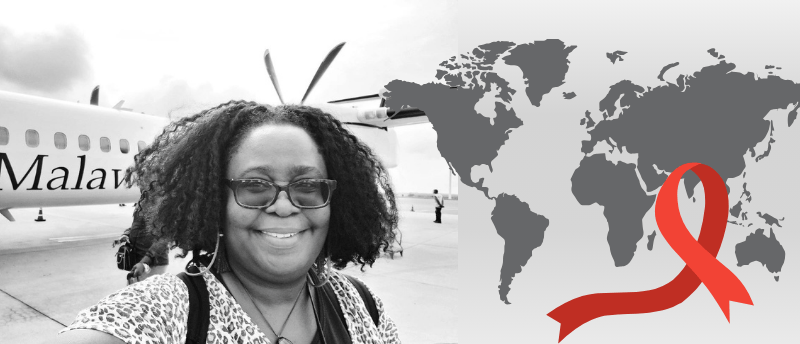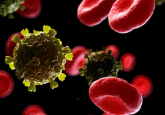Innovations for accessibility: developing HIV-1 diagnostic and monitoring technologies

 Catherine Kibirige (left) is a Senior Research Associate at Imperial College London (UK) who has been involved in HIV-1 research for over 20 years, working directly on patient samples with health ministries and university hospitals. In this feature, we learn about Kibirige’s motivation to pursue HIV-1 research, the technologies she’s developing to make early diagnosis and treatment-monitoring of the disease more accessible, and why that accessibility is so important.
Catherine Kibirige (left) is a Senior Research Associate at Imperial College London (UK) who has been involved in HIV-1 research for over 20 years, working directly on patient samples with health ministries and university hospitals. In this feature, we learn about Kibirige’s motivation to pursue HIV-1 research, the technologies she’s developing to make early diagnosis and treatment-monitoring of the disease more accessible, and why that accessibility is so important.
Uganda was the first country in Africa where HIV was officially reported and characterized. Born and raised in Kenya to Ugandan parents, Kibirige can recollect the devastating effect that the HIV epidemic had on the Ugandan community in Kenya. This experience ignited a desire in Kibirige to find treatments for HIV. Kibirige moved to the UK with her family in the early 1990s, where she studied biochemistry at the University of Bath (UK). Following her graduation in 1999, she visited her mother who had moved back to Uganda. Here, she volunteered in the Rakai Health Sciences laboratory at the Uganda Virus Research Institute (Entebbe, Uganda) and was sent to Rakai where the first cases of HIV in Uganda were identified. The laboratory director at the time was Mary Meehan.
Kibirige ended up working for what is now the Rakai Health Sciences Program, a collaboration between the Ugandan Ministry of Health, Johns Hopkins University (MD, USA), Columbia University (NY, USA) and the US Military, for two years. She received sponsorship from the US National Institute of Health’s Fogarty Fellowship Program (MD, USA) and was accepted by Johns Hopkins for a two-year master’s program in the Molecular Microbiology and Immunology department. After just 1 year on the course, she was placed into an HIV lab to begin her PhD work. It was here that she met Joseph Margolick – who had been involved in characterizing the initial cases of HIV in San Franscisco, where HIV first broke out in the United States. Margolick now heads the Baltimore Washington Arm of what is now the Multicenter AIDS Cohort Study (MACS) in the US and has been involved in developing and updating treatment regimens for the condition. Kibirige gained experience working with HIV samples and meeting patients, while working for the MACS.
Over the 7 years that Kibirige spent working on her PhD, she studied HIV-induced cell death. However, what she eventually realized was that she wanted to do translational research that had greater direct impact on patients and their outcomes. When her PhD was complete, she joined the US Military’s HIV Research Program. She worked in the Technology Assessment Laboratory of the Diagnostics and Counter-Measures Division. As it turned out, the lead scientists in this program had been involved in developing the diagnostics and treatment-monitoring tools for HIV right from the start of the epidemic in the US and globally. Additionally, due to the US Military having troops all around the world, they had a diverse repository of HIV strains. At the time Kibirige was working for them, they were doing a vaccine trial in Thailand; to this day, this RV144 study – as it is known – is one of the only vaccine trials that demonstrated substantial efficacy. They had commissioned a laboratory to run some ultra-sensitive tests on some of the trial samples, but it turned out that there was a new recombinant strain of the virus in that region that their new test could not detect or quantify at all. Kibirige’s job was to figure out exactly why this was and to redesign the assay to overcome this challenge. In doing this, she – alongside her supervisors and mentors, Linda Jagodzinski and Mark Manak – ended up completely redesigning the assay so that it could recognize not only the Thai strain, but other problem strains in the military’s repository.
When her funding for this position ran out, Kibirige returned to Johns Hopkins to study the archival HIV samples that Margolick had collected. He needed an ultrasensitive assay to study limited populations of T cells and determine exactly where the virus was being harbored in patients who had undetectable viral loads but were still showing signs of immune exhaustion and were not doing as well on their treatment. Kibirige thus developed an ultra-sensitive version of the assay with the help of some suggestions she had received from her former colleagues at the military’s HIV Research Program. This project ended successfully, and Kibirige got to present her work at an HIV immunology and vaccines conference where she met a former colleague who suggested she present the work to the International AIDS Vaccine Initiative (IAVI)’s Human Immunology Laboratory at Imperial College London. Here, she realized that the optimized assay she’d been working on over the years could apply to the IAVI’s vaccine screening tool and convinced the Director of the initiative, Jill Gilmour, to allow her to complete the validation experiments on the assay and attempt to use it as an alternative read-out for their vaccine screening tool. Fortunately, because of Gilmour’s previous work in Africa, where most of the IAVI’s field sites are located, she had a close connection to the Director of the US Military’s HIV Research Program; they were therefore granted access to use the specific primers and probes that detected all the different problem strains that Kibirige and her team had developed while she was with their program. With this permission to access a large repository of samples and the availability of newly isolated transmitted founder strains from African field sites, Kibirige and her colleagues were able to extensively validate the assay and release it as a new invention for the sensitive detection of diverse strains of HIV.
Characterizing HIV for the development of sensitive HIV-1 qPCR assays
HIV is an RNA virus. Part of its life cycle is making a DNA copy of its genome and integrating it into the host’s chromosomes. It has a very high mutation rate, which is “why even with the treatments, it’s necessary to target three different parts of the life cycle. It’s why you need to remain on the treatment for the rest of your life once you’re infected. It keeps mutating, and it has a devastating effect on the immune system if it is not kept properly in check.” Additionally, because HIV isn’t being detected early enough, because there are certain high-risk groups and other vulnerable populations who do not adhere well to the drugs and because second- or third-line treatments are more expensive and harder to come by, there is a surge in drug resistance in some areas. This is an ongoing challenge in Africa: “It’s okay we have these [generic] drugs, but if we then become resistant to those that are most cheaply and readily available, then we’ve shot ourselves in the foot. So, we need to become better at monitoring and keeping on top of this and making sure that when people develop resistance, it’s picked up early enough, and then they’re switched over to effective treatments as soon as possible. We also need to ensure that people adhere well to their initial treatments and address the factors that are preventing this.”
As part of the World Health Organization (WHO)’s “Third 95” goal, the United Nations agency is calling for innovative point-of-care or close-to-care solutions for early diagnosis and subsequent treatment monitoring. This goal states that by 2030, 95% of people living with HIV around the world should be aware of their status, and of those, at least 95% should be on treatment, and of those on treatment, 95% should be successfully virally suppressed. The WHO is incentivizing companies by guaranteeing large sale volumes through their network if an assay passes WHO validation and can be scaled up to meet demand. This is making way for new and emerging technologies to enter the field. As funding is now available for these innovations, Kibirige, other researchers and some companies have been able to start working rapidly on ways to combat these issues.
Kibirige uses PCR to detect and quantify even very small amounts of HIV nucleic acids, either RNA or DNA, in bodily fluids or cellular material. The initial HIV-1 assay she and her team developed was published in Nature Scientific Reports. Key to this invention was manually scouring different databases – and using AlleleID – to find regions across the different subtypes of the virus that were most highly conserved. From here, she was able to use a major grove binding probe and – thanks to the development of commercial master mixes that aren’t inhibited by them – crude lysates within her assay. In future work, Kibirige will be using the same type of techniques to upgrade the assay, increasing the specificity so that it meets stringent WHO standards for commercial approval.
Kibirige is developing a commercial kit and optimizing it to work on a small, portable, easily charged instrument that can run up to 48 samples at a time and does not require calibration or regular maintenance. She aims to partner with other companies developing small portable instruments that can either be replaced easily or are hardy enough to withstand the conditions in rural areas in Africa. This will allow for the use of the assay in very basic field centers – or even mobile vans. She is also exploring and utilizing simple and quick bead-based RNA extraction protocols with ambient-temperature reagents that last for a year or more. This is important because in the current system, reagents often arrive with only 3 months left before expiration, which leads to excessive waste. Another challenge that Kibirige faces is the potential for contamination as her current system is quite exposed; when doing PCR in a nonspecialized lab, there are several contamination issues.
Access matters
Kibirige’s desire to be in the field, working with the people affected, has been the main driving force behind her work. The sponsorship opportunity she received to travel to and study in the US was for developing African scientists, which was built on the idea that African scientists could then take that expertise back home. She stresses that there is still a challenge to overcome when getting HIV treatments and assays where they’re needed most: “The money is in the west, but the most people living with HIV and the greatest need is in Africa, actually in rural Africa. I think the big challenge still is how to impact and improve the lives of those who need it most, but have the least resources.”
Kibirige stresses that part of this challenge is improving early detection, treatment initiation and sustained treatment adherence in these populations, which can only be successfully managed with better access to efficient point-of-care or close-to-care diagnostic and treatment-monitoring assays. The current viral load tests require sophisticated equipment and highly specialized staff. In addition, it is essential when working with RNA to have a cold chain for the reagents and samples. As much of the testing is done on large platforms in centralized labs, people living with HIV must go to specific district hospitals where their blood is drawn and then shipped to the central labs for the testing. For people in rural areas, it can take 3 months or more for their test results to come back, which is not ideal for quickly detecting drug resistance, monitoring the effects of improved adherence or a switch to another line of treatment. In Uganda, some of the highest incidences of HIV are in rural areas that are hard to reach. Many of these villages don’t have a basic health center, so their inhabitants are not accessing the healthcare system regularly. Even if great efforts are made to get drugs out to them and they’re given 3- or 6-month doses, there is still a lag in treatment monitoring.
The pilot study
The kit has since been trialed in a pilot study in Malawi. She was encouraged to find that the results produced by her kit were consistent with those produced by huge, complex platforms. However, this study revealed that although the kit provided good, clean data, it may not be point-of-care applicable; it’s not something that a nurse could easily do on the ward, but it’s something that a lab technician should be able to use. Although the current version is more ‘closer-to-care’ than point-of-care, Kibirige shared that she is seeking and organizing partnerships with groups or companies that have simpler assay platforms that may work better at the point of care. “We are continuing to discover other suitable platforms and reach out to the inventors or companies that own them.”
Although previously concerned about the potential for contamination, Kibirige also found that during the pilot study, the technicians were able to keep the open system clean, even in a very busy hospital lab: “We’re quite confident that when we go to the rural hospitals, as long as we really do explain and come up with a system for the PCR workflow, we will be able to use the open system and prevent contamination.” Many lab technicians in Africa already work with PCR when conducting malaria and tuberculosis tests and have a deep understanding of the science. Additionally, once this open system is working consistently for HIV and there are technicians who have the skills and understanding of the process, this system will be available for other diseases, such as neglected tropical diseases.
Looking to the future
It is hoped that the kit and system will be developed to provide a method for diagnosis in infants as well as for treatment monitoring as the disease persists, providing results on the same day as testing, which can be done in one’s local community. Removing the travel barrier, with its associated costs, will help make the process more accessible to a greater number of people and greatly reduce the turn-around time for obtaining results. From a physician’s perspective, receiving rapid results will help them monitor patients’ treatment plans and make informed decisions about their patients’ health.
The next step for Kibirige is analyzing and reporting the data from her pilot study in Malawi and applying for funding for a follow-on study that will involve upgrading the kit to improve its performance and ease of use. Alongside the pilot study, Kibirige has been part of the ICURe Explore Program, which is funded by Innovate UK. This is an intensive market discovery program that offers advice on how to commercially move forward with UK-university based innovations, like Kibirige’s ambient-temperature kit. The program may even offer support for the next phase of commercialization, which would allow Kibirige to use the technology in Africa for widespread diagnosis and treatment monitoring.
Kibirige shared one last challenge that she sees arising even as this technology is adopted in Africa. Getting the technology there and training people to use it is one thing, but implementing the system so that it actually has a substantial positive impact on peoples’ health is another. Kibirige explains that there are many factors that need to align for people to actually benefit from an innovation like this: “In Africa, adolescent girls and young women have an exceptionally high rate of HIV infection, particularly in certain rural communities or high-risk urban settings. There is also evidence to show that certain groups of people living with HIV, such as children born with the virus, are dying prematurely at exceptionally high rates. They tend to be in vulnerable situations and for various reasons are not regularly accessing their medication or, if they are accessing it, they may be living in poverty, may be malnourished and have food insecurity issues and thus cannot take their medication. The drugs must be taken with food and cause severe adverse effects when not taken with food. We aren’t following through on treatment and care in these high-risk and vulnerable populations. So, I think my big challenge now is to follow through and make sure that the innovation meets the people who need it the most as well as making sure that we are implementing efficient systems that take into account local socio-economic and other factors that prevent the successful implementation of these types of interventions.”





